Research, Education & Outreach
Clemson Automotive Training System (CATS)
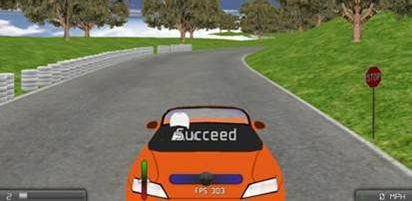 CATS has been developed to educate and train novice drivers to drive safely on urban and rural roads. The road designs are fully customized and can be adjusted to meet the stated situational requirements. The system can be programmed to simulate a variety of high-risk driving scenarios. Extensive driver and vehicle data can be collected and analyzed within the virtual driving simulator. CATS is also a portable automotive simulator, which individuals can download and use at home instead of going to a remote location if the required interface hardware exists.
CATS has been developed to educate and train novice drivers to drive safely on urban and rural roads. The road designs are fully customized and can be adjusted to meet the stated situational requirements. The system can be programmed to simulate a variety of high-risk driving scenarios. Extensive driver and vehicle data can be collected and analyzed within the virtual driving simulator. CATS is also a portable automotive simulator, which individuals can download and use at home instead of going to a remote location if the required interface hardware exists.
Child Passenger Safety Program
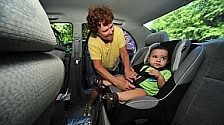 Vehicle crashes remain the number one killer of children 1 to 12 years old in the United States despite advances in vehicle and safety seat design and stronger legislation regarding seat use. The IGRSS Child Passenger Safety (CPS) program began in 2001 and to date has conducted more than 4,000 child safety seat inspections and installations. Additionally, institute faculty and staff have educated more than 15,000 adults and children at permanent and mobile CPS inspection sites across Upstate South Carolina, which was staffed by a nationally certified CPS technician-instructor. Undergraduate students and graduate students from Clemson University have also been involved in experiential learning opportunities in the IGRSS CPS program which was established to assist families to travel safely with their precious cargo as well as to conduct educational and certification programming.
Vehicle crashes remain the number one killer of children 1 to 12 years old in the United States despite advances in vehicle and safety seat design and stronger legislation regarding seat use. The IGRSS Child Passenger Safety (CPS) program began in 2001 and to date has conducted more than 4,000 child safety seat inspections and installations. Additionally, institute faculty and staff have educated more than 15,000 adults and children at permanent and mobile CPS inspection sites across Upstate South Carolina, which was staffed by a nationally certified CPS technician-instructor. Undergraduate students and graduate students from Clemson University have also been involved in experiential learning opportunities in the IGRSS CPS program which was established to assist families to travel safely with their precious cargo as well as to conduct educational and certification programming.
College Alcohol Prevention Program
 Alcohol consumption, binge drinking and driving under the influence on college campuses are on the rise across the country. A significant percentage of young drivers are involved in alcohol-related traffic crashes and are twice as likely as adult drivers to be in fatal crashes. College life supports an atmosphere of freedom of movement and an increased opportunity to consume alcohol. The problems contributing to the high crash rates of young people include risk taking, drinking and driving, poor driving judgments, faulty decision making, inexperience and peer pressure, and driving during nighttime and high-risk hours.
Alcohol consumption, binge drinking and driving under the influence on college campuses are on the rise across the country. A significant percentage of young drivers are involved in alcohol-related traffic crashes and are twice as likely as adult drivers to be in fatal crashes. College life supports an atmosphere of freedom of movement and an increased opportunity to consume alcohol. The problems contributing to the high crash rates of young people include risk taking, drinking and driving, poor driving judgments, faulty decision making, inexperience and peer pressure, and driving during nighttime and high-risk hours.
eCruisers Youth Program
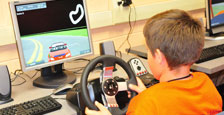 Advancing technology, increasing globalization, and the need for effective team performance offer exciting challenges for education in the 21st century. One area that stands to benefit from these enhancements is the traffic safety and mobility community. CU-IGRSS seeks to create a Virtual Community of Practice around the issue of youth traffic safety.
Advancing technology, increasing globalization, and the need for effective team performance offer exciting challenges for education in the 21st century. One area that stands to benefit from these enhancements is the traffic safety and mobility community. CU-IGRSS seeks to create a Virtual Community of Practice around the issue of youth traffic safety.
Inflation Station
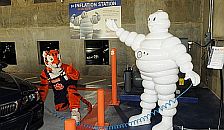 The Inflation Station is unique, one-of-a-kind, safety resource for the driving public. Located on the entrance level of the AutoPark at the Clemson University International Center for Automotive Research (CU-ICAR) at I-85 exit 48A East, the Inflation Station features the iconic “Michelin Man” as a highly visible opportunity for drivers to check and adjust tire pressure as they leave the parking area. Accurate tire inflation pressure is one of the most easily managed - and one of the most easily overlooked - aspects of road safety.
The Inflation Station is unique, one-of-a-kind, safety resource for the driving public. Located on the entrance level of the AutoPark at the Clemson University International Center for Automotive Research (CU-ICAR) at I-85 exit 48A East, the Inflation Station features the iconic “Michelin Man” as a highly visible opportunity for drivers to check and adjust tire pressure as they leave the parking area. Accurate tire inflation pressure is one of the most easily managed - and one of the most easily overlooked - aspects of road safety.
Marine Initiative
 Research team (RPDE and CU-IGRSS) provided a Dynamic Driving Course (DDC) in which participants were taught to recognize high-risk driving (4 wheel PMV) circumstances in non-tactical situations and learn strategies to mitigate the threats from these circumstances. These high-risk driving circumstances included driving with peers, optimistic bias, emotionality, drinking and driving, seatbelt use, distracted driving, and fatigued driving.
Research team (RPDE and CU-IGRSS) provided a Dynamic Driving Course (DDC) in which participants were taught to recognize high-risk driving (4 wheel PMV) circumstances in non-tactical situations and learn strategies to mitigate the threats from these circumstances. These high-risk driving circumstances included driving with peers, optimistic bias, emotionality, drinking and driving, seatbelt use, distracted driving, and fatigued driving.
Petty Safe Driving Program
 CU-IGRSS launched its national Safe Driving Program in partnership with Richard Petty Driving Experience (RPDE) at a news conference at the Atlanta Motor Speedway in March 2007. This unique partnership with the world’s leading provider of motorsports entertainment is designed to prevent traffic crashes by at-risk adolescent and young adult drivers by targeting critical road hazards and risky behaviors. This research-based program offers both classroom and on-track laboratory experiences based on the best vehicle control techniques, life skills training, and education/mentoring conducted in a controlled and safe environment.
CU-IGRSS launched its national Safe Driving Program in partnership with Richard Petty Driving Experience (RPDE) at a news conference at the Atlanta Motor Speedway in March 2007. This unique partnership with the world’s leading provider of motorsports entertainment is designed to prevent traffic crashes by at-risk adolescent and young adult drivers by targeting critical road hazards and risky behaviors. This research-based program offers both classroom and on-track laboratory experiences based on the best vehicle control techniques, life skills training, and education/mentoring conducted in a controlled and safe environment.
Virtual World to Enhance Driver Training
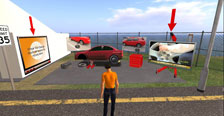 Traffic crashes are the leading cause of death for adolescents in the U.S. Young drivers (15-20) are involved in three times as many fatal crashes as all other age groups. This high crash rate is largely due to a lack of maturity and inexperience in the driving task along with overconfidence and risk-taking behaviors (NHTSA, 2006). There is a need to investigate the use of immersive virtual worlds for novice driver research, education, training, and social interaction.
Traffic crashes are the leading cause of death for adolescents in the U.S. Young drivers (15-20) are involved in three times as many fatal crashes as all other age groups. This high crash rate is largely due to a lack of maturity and inexperience in the driving task along with overconfidence and risk-taking behaviors (NHTSA, 2006). There is a need to investigate the use of immersive virtual worlds for novice driver research, education, training, and social interaction.
Kenya Initiative
 The mission of the proposed Kenya Institute for Global Road Safety and Security-Kenya (K-IGRSS) is to provide teaching, research, and outreach in road safety and security in the Republic of Kenya through a fundamental understanding of the human-vehicle-road system. This institute will demonstrate how government policy, academic research, and public and industry/business support can be leveraged for safer and more secure roads in lower income countries. Multidisciplinary planning efforts in Kenya could then serve as a model for other East Africa and Southeast Asia countries.
The mission of the proposed Kenya Institute for Global Road Safety and Security-Kenya (K-IGRSS) is to provide teaching, research, and outreach in road safety and security in the Republic of Kenya through a fundamental understanding of the human-vehicle-road system. This institute will demonstrate how government policy, academic research, and public and industry/business support can be leveraged for safer and more secure roads in lower income countries. Multidisciplinary planning efforts in Kenya could then serve as a model for other East Africa and Southeast Asia countries.


